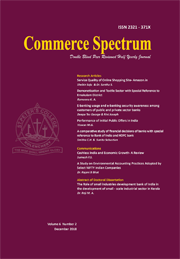Effect of Genre of Sponsorship on the Performance of Mutual Funds
Author(s) : Dr. Tomy Mathew, Ann Elizabeth JohnVolume & Issue : VOLUME 2 / 2014 , ISSUE 1
Page(s) : 11
Abstract
In any given country Mutual Funds operate in similar regulatory framework, the investors will be almost homogenous, the markets are rather efficient and the operating expenses will be more or less the same. However, there are differences in the performance of mutual funds. The performance of mutual fund may be influenced by the type of sponsorship. This paper examines the effect of type of ownership on the performance of Mutual Funds.In India mutual funds can be categorized into three on the basis of sponsors viz., bank and institution sponsored, private sponsored and foreign sponsored mutual funds. The performances of mutual funds are evaluated with the help of Sharpe measure, Treynor measure and Jensen measure. The study found that disparity does not exist in the performance of mutual funds on the basis of type of sponsorship. ANOVA test confirms that there is no difference in the performance among Mutual Funds.
Keywords
Mutual Fund, Sharpe measure, Treynor measure, Jensen measure
References
Association of Mutual funds in India . (2013, September 20). Retrieved from Monthly Data on Mutual Funds in India: http://www. amfiindia.com/spagesammay2013repo.pdf.
Association of Mutual funds in India. (2013, September 20). Retrieved from Net Asset Value History:http://www.amfiindia.com/ amfimembers.aspx
Investment Company Institute. (2013, October 3). Retrieved from Worldwide Mutual Fund Market Data:http://www.ici.org/research/stats worldwide
Kamat,V. (2013, September 20). Retrieved from Indian markets are far more volatile than others: http://www.livemint.com/Money rkS7ko Y3m PmB2LKKEzLyUK/Indian-markets-are-farmore- volatile-than-others
Kumar, S. (2008). Financial Derivaties. New Delhi: PHI Learning Private Limited.
Press Trust of India. (2013, September 20). Retrieved from India’s GDP growth likely to be at 5.2% in 2013: UNCTAD.: http:// www.thehindubusinessline.com/economy/ indias-gdp-growth-likely-to-be-at-52-in-2013- unctad/article5120306.ece
Weston, F., & Brigham, E. F. (1997) Financial Instruments and Services. Prentice Hall India Pvt., Limited.
(Footnotes)
1 http://www.ici.org/research/stats/worldwide
2 In its release of Trade and Development Report 2013, the United Nations Conference on Trade and Development (UNCTAD) said the Indian
economy is expected grow at 5.2 per cent in calendar year 2013 as against 3.8 per cent in 2012. (Source: http://www.thehindubusinessline.com/ economy/indias-gdp-growth-likely-to-be-at-52-in- 2013-unctad/article5120306.ece)
3 The Reserve Bank of India’s Handbook of Statistics (September 2013) shows that investment in shares and debentures constituted 3.1% of the incremental financial assets of the household sector in fiscal year 2013. (Source: http://www.livemint.com/Money/ rkS7koY3mPmB2LKKEzLyUK/Indian marketsare- far-more-volatile-than-others.html?ref=dd)
4 http://www.ici.org/research/stats/worldwide
5 http://www.amfiindia.com/amfimembers.aspx
6 http://www.investopedia.com/terms/i/ investment.asp
7 All mutual funds are governed under SEBI guidelines - SEBI (MF) Regulation - 1993
8Vaidyanathan&Gali (1994) and Ray & Sharma (2008), inter alia, provided empirical evidence.
9 Section 52 of SEBI (MF) Regulations of 1996 stipulates that Operating expenses, adhering to the limits prescribed by it, can be charged on the income of Fund and should be disclosed in the annual accounts of the AMCs.
10www.amfiindia.com/spages/ammay2013re po.pdf . (Table: 4)
.png)

